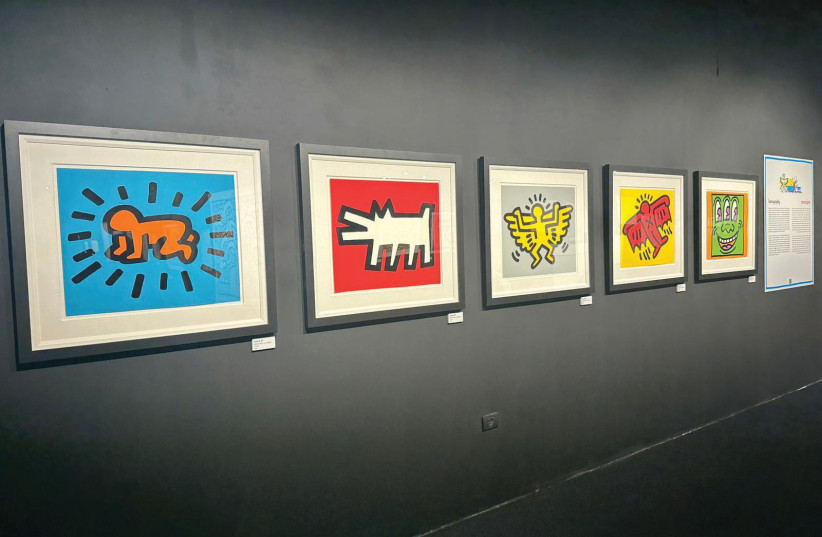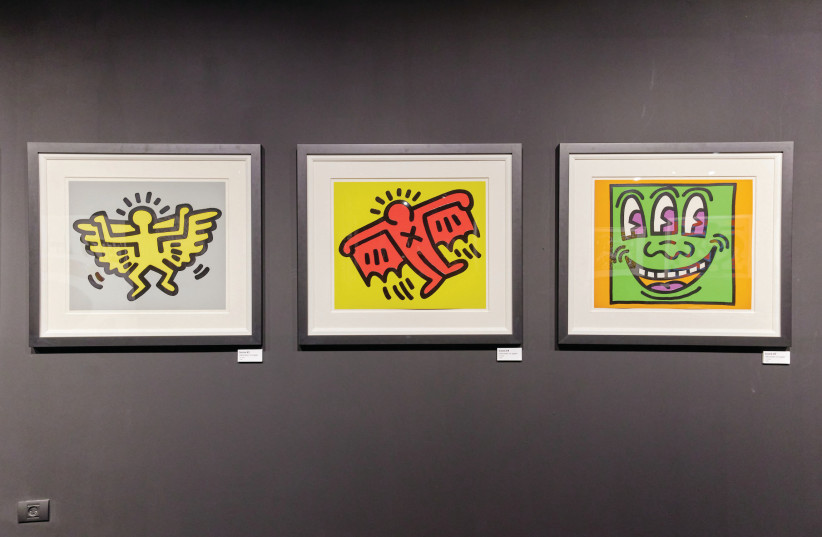Keith Haring is iconic… for his icons. Consider the “Radiant Baby” or the “Barking Dog.” You have probably seen the images, but not known much about the simple, colorful figures which have become Haring’s signature.
Now, the Arena Mall in Herzliya has unveiled a new exhibit called “Untitled by Keith Haring.” The exhibition, which has appeared in New York, Florida and Italy, will present approximately 200 original works of one of the world’s most prominent, cheeky, and successful pop art artists. Haring’s art emerged from the New York City graffiti subculture of the 1980s. Much of his work includes sexual allusions that turned into social activism by using the images to advocate for safe sex and AIDS awareness.
Haring died of AIDS-related complications at the age of 31 in 1990, and since then, he’s been the subject of several international retrospectives. Today, his works can be seen in the exhibitions and collections of major museums around the world.
Haring’s works show basic representations of people and animals in everyday life, rejoicing with hands in the air, leaning into an embrace or even engaging in a sexual act. You might not see it right away, but Haring’s pop art offers a glance into the world as he saw it through the 1980s. The openly gay artist worked mostly using the streets and subway stations of New York City as his canvas, but ultimately executed his first solo show at the Stedelijk Museum in Amsterdam in 1986. While New York City has always been progressive, Amsterdam at the time served as a safer place for Haring’s explicit, homosexual drawings. The exhibit in Herzliya has a display of those works, too.
HARING FILLED up empty black posters that covered past adverts in subway stations using chalk. His drawings filled public spaces with art, persevering in his work even after being arrested by New York City authorities for illegal graffiti. The Black Box has an installation that will make you feel as if you were walking through New York’s 51st Street station, equipped with mimic mosaic tiles and nostalgic shiny orange seats. The dark exhibit space shows off a language that has remained a part of pop culture, even some forty years later. One gallery guest even chalked the icons up to a modern hieroglyphic.

Famed New York-based photographer Allan Tannenbaum was flown in as the show’s guest of honor. Tannenbaum is responsible for many of the most popular photos of Haring, which captured his essence and passion for paint and time and again have accompanied Haring’s exhibits around the world.
Before his untimely death, Haring set up the Keith Haring Foundation, which used art as a tool for safe sex awareness and also supported education, prevention and care for those suffering from AIDS. The efforts of his foundation continue today.
Access to international art for all
“What an amazing artist Keith Haring was. The variety of his work; the scope of it. There’s a lot of things I’ve seen before and many things I have not. I really want to take it all in,” Tannenbaum said.
When asked what he hopes people would take away from his contribution to the exhibit, Tannenbaum said it was his photos, which have themselves become fine art prints all these decades later.
ArtHub CEO Roy Milo says so much uncertainty toward the end of the Covid-19 pandemic caused the Haring exhibit to take a lot of time to secure. In comparison to other major cities around the world, choosing an artist to highlight takes a lot of courage. While London, for example, has a population of just about nine million, Israel has that many for its entire nation.
When trying to make the money back on an exhibit, it is, as Milo says, ‘a gamble.’ ArtHub spends between NIS four and eight million on most any given exhibit. Milo tells The Jerusalem Post that he and his team are always trying to pinpoint what an Israeli audience would like and then create the experience.
“Keith Haring is a very colorful exhibition, and it’s not like Claude Monet, Van Gogh, Frida Khalo, Picasso,” he says. “In comparison to all of them, Keith is rather young. And he has a story. He started in the street; he started a movement. A lot of people are familiar with his art without actually knowing his name.”
Milo also spoke to the exhibit’s family appeal, explaining the installations were built to be a 360 experience with artful cubes for children to sit in and other sections that offer videos to watch.
“Our part is to make sure that everyone in Israel has access to international art,” Milo said.
While ArtHub is working to make international shows available for Israelis locally, Haring is known until today for having a similar spirit. He is considered a fundamental part of postmodernism, making art available for the everyday New Yorker. Art and culture expert Alon Klebanoff says Haring stands shoulder to shoulder with the men and women who turned French palaces into public museums during the French Revolution of the late 18th and early 19th centuries.

“Turning subway stations into museums broke the boundary line between street art and high art and [he] managed to marry them together,” said Klebanoff. “In a place where market forces and making a buck is almost a religion, he says ‘no – I will not wait for my first million, I will create art for everyone.’”
Keith Haring’s show runs from March 9 through June 30, from 10 a.m. until 7 p.m. with a last entry of at 5:30 p.m., with a shorter day on Fridays and holidays. Tickets cost NIS 119.
